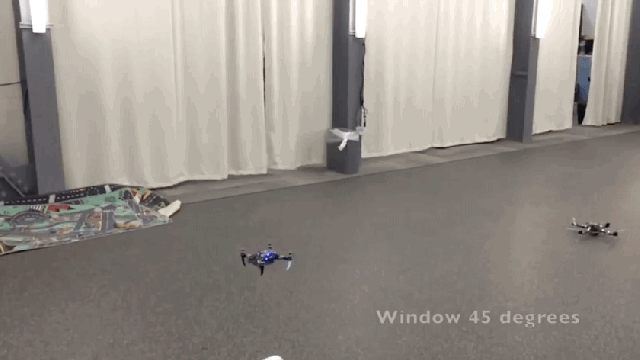Quadrotors need outside help to navigate and perform their remarkable stunts, whether it be a human behind the controls or an array of complex sensors placed around a room. But not this one. Developed by researchers from the University of Pennsylvania, this drone is practically autonomous — which means it’s an actual drone. The future is finally here.
As tech writer Evan Ackerman writes at IEEE Spectrum, Vijay Kumar’s lab at the University of Pennsylvania has succeeded in getting quadrotors to make aggressive manoeuvres using only onboard sensing and computing, “meaning that no window is safe from a quadrotor incursion. None. Anywhere. You’ve been warned.” Indeed, it’s an achievement that takes quadrotor flight to the next level.
Normally, external motion-capture systems are what allow quadrotors to zip and flit through the air, guiding them as they dodge obstacles and navigate through hoops. These systems, like the Vicon motion-capture system, record boatloads of information about a given room, and then transmit that critical information to the drone. In essence, the drone is “dumb”, and it’s the external system that’s actually guiding it.
That’s all fine and well for a university lab, but the inability of a drone to fly on its own is clearly a huge limiter. Without their fancy navigation systems, quadrotors are unable to do many of the things we actually expect autonomous drone to do in the real world, like fly through a window.
Now, after six years of tedious work, the Vijay Kumar Lab researchers have developed a small quadrotor that’s equipped with a single camera, a computer and an IMU (intertial measurement unit) which allows it to know where it is in space, and then perform trajectory calculations as it executes a planned path. Essentially, the researchers took a room’s worth of external technology and packed it all onto a 250-gram quadrotor. That’s amazing.
“This is the first time that aggressive maneuvers are solved with such a small footprint vehicle using only onboard sensors and without relying on external motion-capture systems,” note the researchers.
But as Ackerman explains, there is a caveat: “the location of the obstacles relative to the starting position of the quadrotor are provided to the robot in advance.” This is because its front-facing stereo camera can’t perform the dense mapping required for such a feat, but the researchers say they’re going to resolve this limitation fairly shortly.
Still, what this machine is doing is extraordinary. While in flight, the quadrotor is estimating its location and orientation in space 500 times a second. It can reach speeds of 4.5m per second, accelerate at 1.5 g and roll and pitch at angles of up to 90 degrees.
A few more tweaks by these developers and we could finally start to see these tiny drones in the real world. You may want to keep your windows shut.
